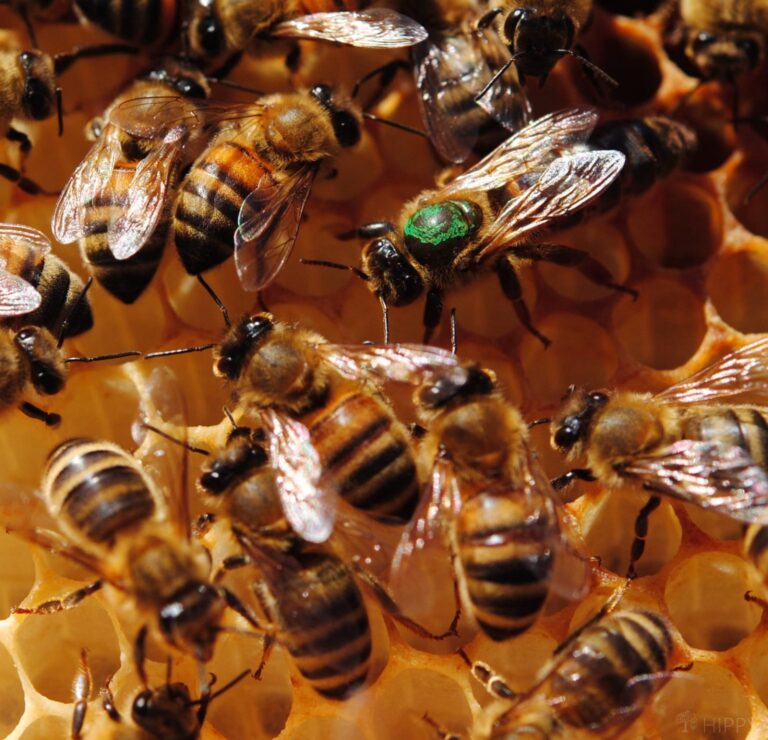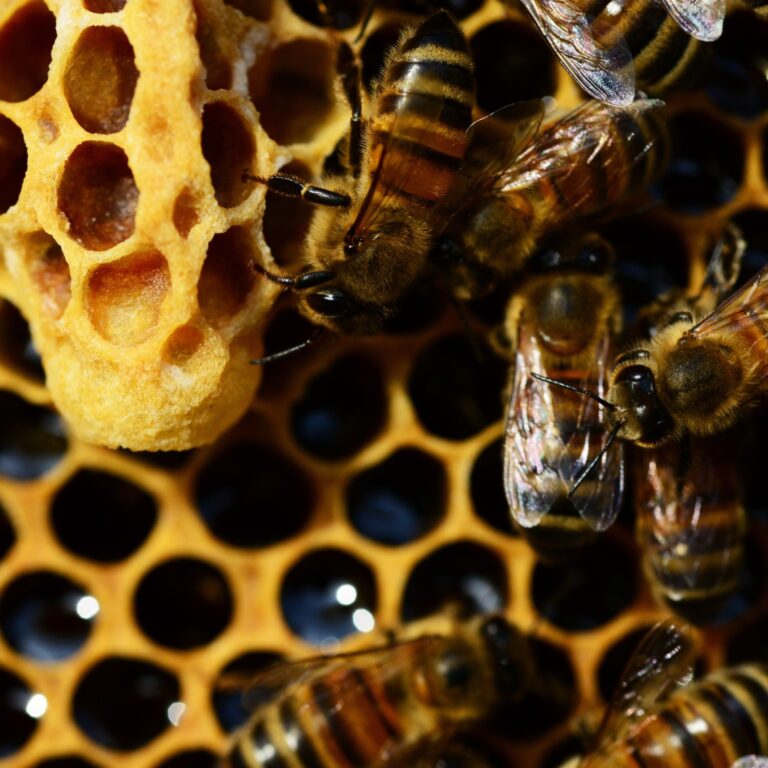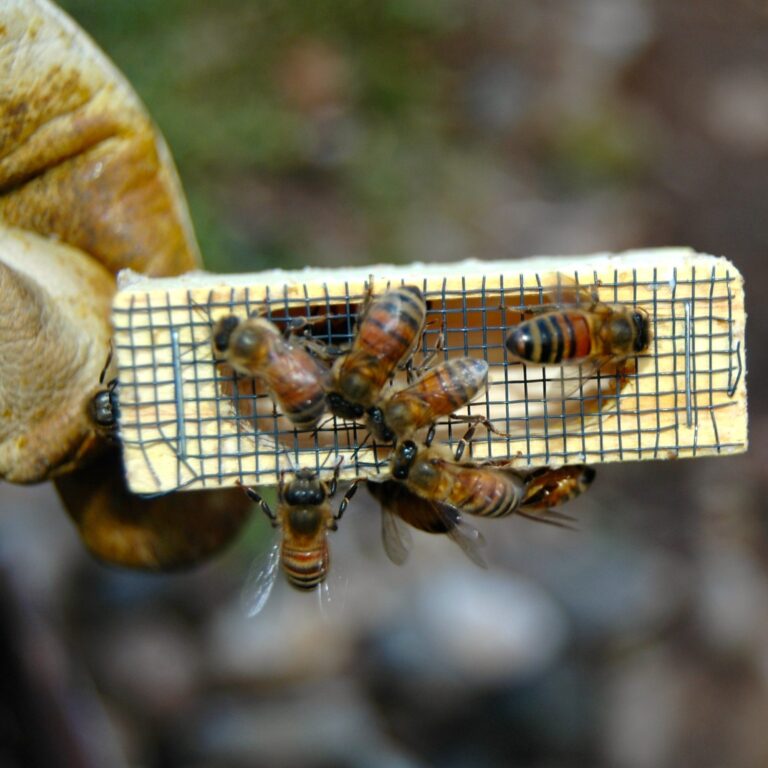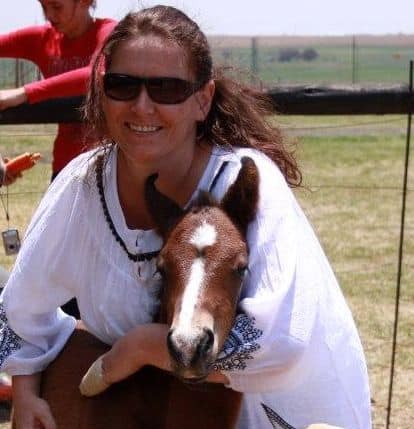The queen bee is the most important member of any colony. She can live for three to four years while her underlings can only live a few weeks.

Only the queen bee mates and can lay female eggs; the workers are all female. She is therefore critical to the survival of the hive.
If your queen bee dies, she will need to be replaced immediately. Most of the time the worker bees will know what to do and immediately start raising a couple of queen cells using royal jelly to feed larva, but occasionally, we have to step in to save the hive.
Each colony has only one queen. If a second queen is introduced or hatches while the queen is alive, the worker bees will attack and kill her to protect their queen.
But what happens to the colony if the queen bee dies?
How to Identify Queenlessness
If you are doing regular inspections, you will know where to look for your queen and you will be able to identify that the queen bee is either dead or missing.
Start by looking at where the worker bees are congregating. The worker bees mostly congregate around the queen to seal up eggs and tend to larva.
Also, check where the newest brood cells are. The queen will work in one area at a time to lay eggs. This means she will be in the area of the newest brood cells.
Check the bottom of the hive. If she is dead, that is the most likely place where you will find her.
How Is the Hive Affected by the Death of the Queen?
Because of her importance to colony survival, the queen will have to be replaced immediately.
The hive will continue to function for about five days, so there is time to correct the problem by introducing a new queen.
Often worker bees will lay eggs, but because they are not fertilized, they will only produce drones.
The colony may become agitated and more aggressive if the queen dies, and the only thing that will settle them down is a new queen.
If you listen to your bees, you will also detect a change in the noise of the hive. A happy hive that has a queen emits a contented, happy buzz.
If the queen is dead, they up the volume significantly. You will hear that they sound like they are panicking and in a frenzy.
Can the Hive Make a New Queen?
Often the worker bees will select a few eggs that are three days old and focus on raising these as new queens.
Normal eggs are all fed royal jelly for the first three days. If the workers are trying to raise a queen, the selected cells will continue to be fed royal jelly for the whole gestation.
The workers will also work on enlarging the selected cells to accommodate a queen as queens are significantly larger than workers.
These enlarged cells are called queen cells. Each queen cell will be roughly an inch long and it will stand out from the cells around it.

From time to time, you will see queen cells in amongst the brood cells while the queen is alive. If the queen hatches, she will be killed.
You should pay attention to these cells as they can be a source of revenue if you sell the queen. They will need to be removed from the hive before they hatch.
From the time the egg is laid to the time the new queen can be laying eggs will take about 70 days.
What Happens If No Queen Cells Develop?
If your queen dies, and the workers are not successfully raising a queen, one of two things would happen unless you intervene.
- The hive will die as there are no replacement workers hatching
- Your bees will swarm in search of a hive with a queen
What Can Be Done to Avoid Losing the Colony?
The first thing you should do if your queen dies is to remove her body. The hive reacts to her smell that lets them know all is well in the colony. The scent of the dead queen will make the hive more restless and aggressive.
You can take a brood comb from a healthy hive and introduce that to the hive. Often the workers will select cells on a new comb to raise queens.
You should inspect the hive regularly to check among the brood cells for queen cells. If queen cells are present and you can see that the larva is doing well, you should be in the clear.
A queen will be born and, unless you remove the extra queen cells, the workers will kill the other queens.
Queens emerge from queen cells after 15 to 16 days. If the workers are raising a queen, because the eggs would have been three days old when selected, your new queen should emerge twelve days after the queen dies.
If you do not see any queen cells developing, you will need to take action quickly.
You will need to introduce a new queen urgently.
If you are concerned about losing your hive, you should consider buying a new queen immediately. That way you will not lose time waiting and hoping for a queen to emerge.
You can purchase a queen; she will come in a cage that you can set at the top of the hive.
If the colony does not have a queen, the bees will immediately start tending to her and feeding her. They understand that the survival of the colony is in her reproductive ability.

If there is a queen and you just did not find her, the workers will aggressively attack the new queen.
Conclusion
If you want your colony to survive and stay where they are, your hive inspections are essential.
You need to know where your queen is, that she is alive and that she is laying eggs. Without those eggs, the colony will die.
You will be able to identify the queen cells easily. They stand out against regular cells as they are larger and have more wax around them.
If the queen dies, you will need to monitor the situation carefully over the next few days. If no queen cells appear, you must replace the queen.
If you do not see queen cells forming within five days, I suggest you introduce a new queen.

Di-Anne Devenish Seebregts was raised in an environment where daily life consisted of hiking, environmental conservation, growing fruit and vegetables, and raising poultry for meat and eggs.
She combined her passion for the writing word with her love of the pride that comes with not relying on others. She raised three children (who are now adults) to value the environment, and understand the value of being self-sufficient.
Find out more about Di-Anne on our About Us page.
